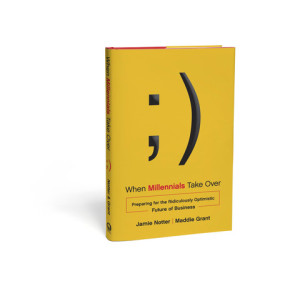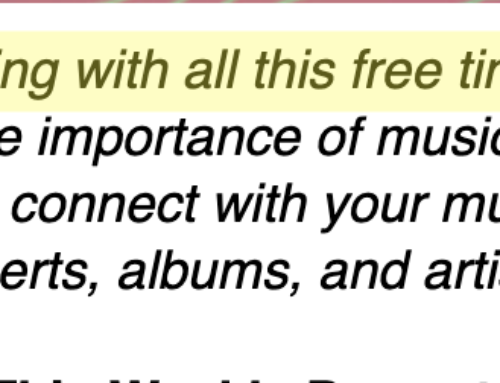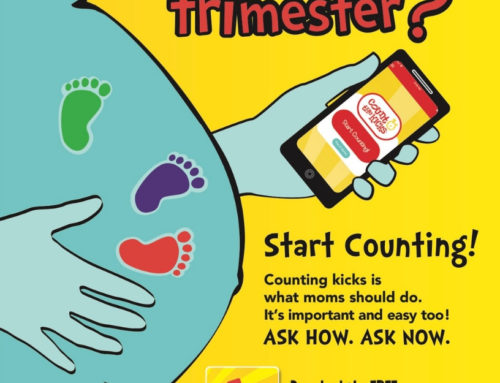 By all accounts, Maddie Grant and Jamie Notter’s new book, When Millennials Take Over, launched to riotous success at SxSW last week. I’m going to now add my $0.02 (and yes, book reviews are back on WUL!) – it’s awesome. Go get it (disclosure: I received a free review copy but no other incentives, monetary or otherwise).
By all accounts, Maddie Grant and Jamie Notter’s new book, When Millennials Take Over, launched to riotous success at SxSW last week. I’m going to now add my $0.02 (and yes, book reviews are back on WUL!) – it’s awesome. Go get it (disclosure: I received a free review copy but no other incentives, monetary or otherwise).
What When Millennials Take Over is about
About a month ago, Maddie authored an extremely comprehensive overview of the book on Social Media Today. You can also grab a sample chapter here (you’ll have to give them your email address, which I think is fair). And here’s a bit of how the marketing copy reads:
Is your organization ready for what’s coming?
Whether we are ready for it or not, the future of business is here. It’s one in which companies must learn how to move faster, flatten their hierarchies, share more openly, and operate more digitally. This “new normal” is one in which social media has permanently shifted the balance of power between individuals and institutions; and the millennial generation (soon to be the largest generation in the workforce) is pushing us to be more transparent, decentralized, and collaborative. The result? Organizations of all sizes and from all industries – especially those who cling to outdated, conventional models – are struggling to stay relevant to customers, capitalize on opportunities in the marketplace, and attract top talent.
Successful companies, on the other hand, are shifting to embrace four key capacities that will drive the future of business: digital, clear, fluid, and fast. These capacities generate the results that have been eluding so many organizations in the last decade: more engaged employees, higher-value customers, greater strategic agility, and stronger, magnetic cultures. These ideas make intuitive sense to Millennials, who are now moving into management positions, but more importantly they are at the heart of companies with the strongest and most powerful cultures””organizations that are thriving in today’s disruptive, fast-paced, and technology-driven world.
The book then goes through these four capacities in successive chapters, with a good number of in-depth case studies to make the authors’ points. Each chapter concludes with concrete suggestions of what you can do to bring your organization up to speed. And at 142 pages, it’s a very quick and, more importantly, engaging, read.
What When Millennials Take Over is really about
 WMTO is about everything I (ok, Maddie and Jamie) said it’s about. But it’s really about much more than just “when Millennials take over,” though that certainly makes for a catchy (and true) title.
WMTO is about everything I (ok, Maddie and Jamie) said it’s about. But it’s really about much more than just “when Millennials take over,” though that certainly makes for a catchy (and true) title.
It is a fascinating look at core, revolutionary societal change … that happens to be taking place during the Millennial rule [sic], and that must be examined in an historical context to truly be understood. And this historic revolution that is taking place (M&J say “it’s coming,” but I think it’s already here) is leading to fundamental changes in the way businesses work, and the management thereof, because of the congruence of social technologies, how they’re changing the way we communicate and interact, and the generation that happens to be sitting at the center of this congruence.
From Chapter 2:
[Generational biographers William] Strauss and [Neil] Howe identify a … cyclical pattern that more closely resembles the repetitive turning of the four seasons than a straight timeline from past to future. Each “season” in this cycle is represented by a single generation, which turns every 20 years or so, and every four “seasons” the cycle completes, marked by a major societal transition.
… When you look at the pattern, it’s almost frightening in its accuracy. Once every four generations (roughly 80 to 100 years), there has been a major war that marked the end of one era and the beginning of a new one. The first transition was during the Revolutionary War in the 1770s, obviously a big shift as the Colonial era gave way to our first era as an independent nation. Flash forward 80 or 90 years from that point and you end up in the American Civil War, and then four generations later, like clockwork, there is another transition: the Great Depression and World War II, which represents the transition between the pre-modern and modern eras in the United States.
Here’s where it starts to get even more interesting. If you skip ahead 80 years from the Depression and World War II, you end up in the present, rather than the past. It’s right now. Today. 2010 to 2020.
WMTO is really about understanding business in the digital age.
It’s about learning how and what “instant” communication really are (hint: not email), and how to communicate more efficiently, for better business results.
It’s about understanding that digital technology does not a digital organization make; digital is a culture, a mindset. (Kinda like social PR.)
It’s about understanding that community is at the core of what makes businesses function at their best, whether that’s your internal (employees) or external community.
It’s not so much about getting ahead (though companies that are implementing these principles are already ahead), but about staying fresh, staying true, and staying relevant.
It’s about – as cliched as this is going to sound – being the best that you can be, because you only have one shot at life… and your life’s work.
I tend to be a bit jaded when it comes to business books, but I came away from WMTO refreshed. I highly, highly recommend it. You can find it on Amazon, or get the Kindle version for only $2.99 (!), or get a signed copy here.
Disclosures (some repeated): I received a free review copy of When Millennials Take Over, but no other incentive(s) for this review. I know Maddie and Jamie, and like them both. But that did not influence my review of the book, because I have very little patience with bad business books. It happens to be a really good, really well-written book.









bowden2bowden I’d love to know what you think after you read the book. maddiegrant jamienotter show why this generation is different.
shonali not sure they are taking over anymore than a previous gen did loaded with ideals and dreams mmangen leaderswest
shonali it’s our pleasure! :) PamDidner maddiegrant jamienotter
LisaPetrilli Thanks, Lisa!
PamDidner Tenacity5Media Belated thanks for sharing my #WMTO review by maddiegrant jamienotter
ShellyKramer IgorBeuker MeghanMBiro TYVM for sharing my review of #WMTO by maddiegrant jamienotter
bowden2bowden mmangen leaderswest I’m curious, what are your thoughts on Millennials taking over? And TY for sharing my #WMTO review!
pablolorentz MarkSBabbitt Thanks for sharing my review of #WMTO by maddiegrant jamienotter